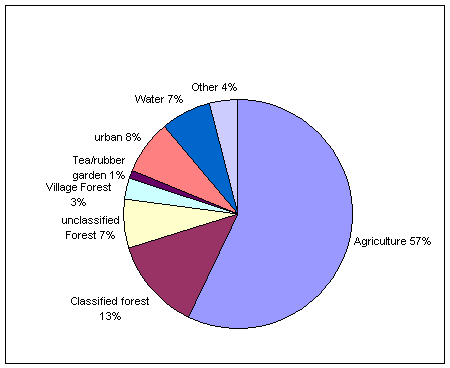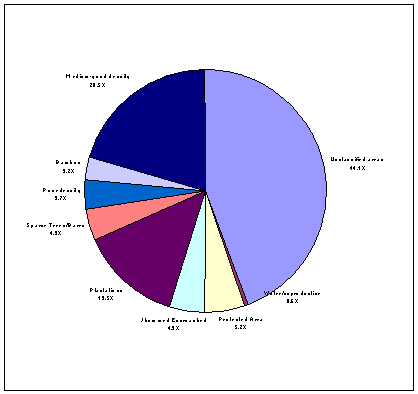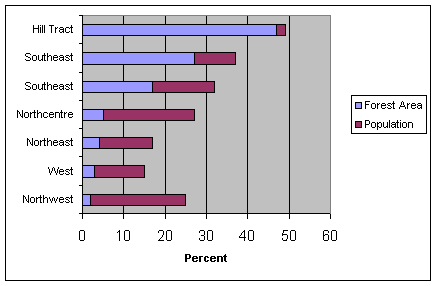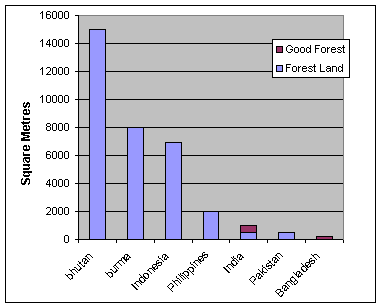Agricultural activities dominate the national economy and account for 38% of gross domestic product (GDP). The scarce land resource is subjected to continuously increasing pressure by a growing population. Considering the size of the agricultural population, the availability of arable land per capita is less than 0.1 hectares. This level of population pressure has made it difficult to make landuse allocations based on land capability.
Farm Size and Farming Intensity - Farm land distribution is quite skewed, average property size is about 0.8 hectares. This average, however, camouflages great unevenness in land distribution. About 40% of the rural population is classified as landless. Small groups of affluent land owners hold land much in excess of their family needs. Some of this excess lands is share cropped by landless labourers. In the case of small and medium land holders, fragmentation of land holdings is increasing alarmingly and impedes efficient utilization.
1983-84 official data indicate that 57% of the total number of rural households are landless and more than 50% of their income comes from non-farm activities. Therefore, economic development and poverty alleviation must focus on increasing intensity of farming and on increasing non-agricultural income. Forestry could play a much more important role.
 Figure 1 - Bangladesh land use distribution (total 14.4 million ha)
Figure 1 - Bangladesh land use distribution (total 14.4 million ha)
Bangladesh Forest Land (total 2.24 million ha)

Nature is bountiful in Bangladesh, but it is poorly managed and exploited. In spite of considerable progress in food grains production, self-sufficiency has not been achieved due to rapid population growth. Of the present net cropped area (8.84 million hectares), 49% is single cropped, 42% is double cropped and 9% is triple cropped. Improving the situation calls for diversified development, expanding horticultural crops, growing multipurpose trees, and intensified farming methods.
Livestock and Fisheries - Livestock can be found on most farms. The most recent 1983-84 Census indicates 22 million cattle, 14 million sheep/goats and 74 million poultry are present in the country. Small farms account for a share of 43% of all cattle and about 50% of the sheep, goats, and chickens. Grazing facilities for cattle are very limited in rural areas and are mostly of poor quality. Some 75 million tons of fresh dung is produced annually, of which about 50% is used as manure and the rest as cooking fuel.
Fishing in ponds, inland water bodies and the inundated flood plain is an important activity. Apart from hydrological characteristics, the nature and distribution of vegetation plays an important role in influencing the fish yield. Some 768,000 fishermen are involved in inland fishing and 510,000 in marine fishing.
Agricultural, rural and cottage industries, and related activities accounted for more than 90% of all private employment in Bangladesh. Farming alone accounts for nearly 60% of all labour. The crude rate of participation in employment is 31%, unchanged since 1984-85. Industrial sector growth remains slow due to a number of factors. While agriculture's share of total employment decreased from 85% in 1950/51 to 58% in 1988/89, the corresponding change in the industrial employment rose from 4% to only 14%.
The number of industrial units in the country is about 30,000 out of which 80% are cottage industries. Early industries utilized renewable local resources such as jute, sugarcane, tea, tobacco, cotton, forest-based raw materials and hides and skins because of the agrarian nature of the economy. The use of non-renewable local raw materials began in the sixties. During the second half of the sixties, a modern industrial base with heavy industries developed. Many of these industries use imported raw and intermediate materials. In recent years a garment industry developed, mainly for export.
The limited development of industry is also reflected in the pattern of energy consumption and sources. Total energy balance in 1990 indicated that the share of commercial energy was 27% (up from 17% in 1981) and that of biomass energy 73% (down from 83% in 1981). While the bulk of the total energy consumed (about 73%) was accounted for by the household sector for subsistence purposes, industry accounted only for about 17%. Commercial, transport and other sectors consumed the rest.
Households predominantly use biomass fuel for cooking (100% in rural households and 70% in urban households) and kerosene for lighting (93% in rural households and 76% in urban households). Average energy consumption per capita in 1990 was reported as 57 kilograms of oil equivalent. Energy use is generally inefficient.
An important aspect of production and use of energy in Bangladesh is the regional disparity in the availability of energy sources. Most of the known resources of fossil fuel, the only source of hydro-power and a major portion of State forests are located in the east zone. Other areas, which are densely populated, have to depend, to a great deal, on whatever is locally available - i.e. agricultural residues and homestead vegetation, especially for domestic purposes.
Inadequate infrastructure is also a constraint, slowing the economic growth of the country. Transport, storage and communication facilities need further upgrading. The large number of rivers facilities cheap water transport, but are often seasonally disrupted due to floods or lack of sufficient flow. Expanding the land transportation network is also made difficult by the presence of many rivers.
The pattern of employment in 1989 indicates that 31% were self-employed, 42% were unpaid family helpers, 14% were employees and 13% were casual labourers. Officially reported unemployment is 1.1%, a rate which masks massive underemployment. The projections indicate that there will be an increase of 32% in labour force between 1990 and 2000. This calls for substantial generation of new employment opportunities.
Bangladesh has very low wage rates, this differential from other countries is advantageous in the short and medium term for developing export oriented and labour intensive enterprise, provided workers are given necessary training. The recent growth of the garment industry is an example of this. The situation of unemployment/underemployment and low rate of earnings has prompted the migration of skilled labour. Bangladeshis employed abroad in 1989 remitted $771 million, a sum equal to about 60% of the country's merchandise exports.
The incidence of poverty in Bangladesh is alarmingly high compared to neighbouring countries. Estimates show that during the last 25 years the poverty situation has not improved. The number of people below the poverty line was estimated at 43% for 1988/89, similar to 1963/64 rates. The corresponding figures for other countries in 1988-89 were: 35 for India; 23 for Pakistan; and 27 for Sri Lanka. 1990 gross national product (GNP) per capita of Bangladesh is $210, compared to: $350 for India; $380 for Pakistan; and $470 for Sri Lanka. The average annual growth rate of GNP per capita in Bangladesh between 1965-1990 was 0.7%, compared to 1.9% for India; 2.5% for Pakistan; and 2.9% for Sri Lanka.
In 1990, Bangladesh's GDP (gross domestic product) equalled $22,880 million with the forestry sector constituting about 3% of this. This does not, however, reflect the true importance of the forestry sector due to the problem of valuation. Also, the various benefits and multiplier effects attributable to forestry are often assigned to other sectors such as industry, services and agriculture. During the five year period of 1991-95, an average annual GDP growth rate of 5% is the target sectoral growth rate, 3.6% for agriculture and 9.1% for industry. GDP growth in Bangladesh, during 1980-90, was 4.3%, agricultural production grew at 2.6%, industry at 4.9%, manufacturing at 2.8% and services at 5.8%.
Bangladesh suffers from a persistent negative balance of trade and current account deficit. Total external debt as in 1990 stood at $12.2 billion (up from $3.8 billion in 1980). During the period 1980-90, gross domestic investment in Bangladesh grew negatively at -0.6% (as against 5.0% for India, 5.7% for Pakistan and 0.4% for Sri Lanka). For the year 1990, gross domestic savings were only 2% of GDP. Almost 90% of GDP was accounted for by private consumption and 9% by government consumption. Gross domestic investment of about 12% of GDP was based mostly on external assistance, thus indicating a resource balance of about -10% (and a development assistance of over $2 billion, equivalent to about 83% of total investment).
The high level of dependence on external sources for public investment will persist at least for several years. The investment financing gap, met from external sources, over the Fourth Five Year Plan (1991-95) exceeds $9 billion (constant 1990 prices).
Table 1 Bangladesh Land Area Classification
Landuse Category |
Hectares | |
Million |
Percent | |
Agriculture |
9.25 |
64.2 |
State Forest |
||
Classified |
1.49 |
10.3 |
Unclassified |
0.73 |
5.1 |
Private Forest |
||
Village |
0.27 |
1.9 |
Tea/Rubber Garden |
0.07 |
0.5 |
Total |
2.56 |
17.8 |
Urban |
1.16 |
8.1 |
Water |
0.94 |
6.5 |
Other |
0.49 2.59 |
3.4 18.0 |
Total |
14.40 |
100.0 |
Figure 2 - Regional forest land and population

Agricultural land makes up 64% of Bangladesh's land area, forest lands account for almost 18%, and urban areas account for a further 8% (Table 1). Water and other land uses account for the remaining 10%. Table 1 presents figures, showing that total forest land area totals 2.56 million ha, including officially classified and unclassified state lands and forest lands accounted for by village forests and tea/rubber gardens. In the case of private forests, the data represent tree covered areas, but this is not the case with the state areas. Most of the state forest land is devoid of trees. Classified and unclassified forest land merely designates government-owned land once covered by forests and it signifies an administrative or legal category, not necessarily areas with forest cover.
Table 2 gives the most up to date summary of actual forest area shown in figure 2. This data shows that the natural forest accounts for almost 31% and forest plantations 13% of total forest areas. Shifting agriculture plus illegal occupation cover 5% of forest lands while water (9%) and unproductive area (0.6%) and other areas (35%) account for almost 45% of forest land. Presently protected areas represent just over 5% of forest land. BFD is responsible for administering 65% of state forest land (about 1.46 million ha) .The balance comes under local District Commissioners.
Excluding parks and sanctuaries, but including the better quality natural forest (medium to good density) plus bamboo areas and plantations gives a figure of 835,000 ha of reasonable quality forest vegetation on state forest land. This equals 5.8% of Bangladesh's total area. The area included in the present protected area network is 116,700 ha, equal to 5.2% of state forest land or less than 1% of Bangladesh's total area.
Figure 3 - Per capita forest land and forest cover

Tabular data rest on outdated forest inventories, excepting the Sundarbans mangrove forest. Social unrest in the tribal hill areas has compounded the problem of getting more reliable estimates for the remaining area outside of the Sal forests.
In terms of forest land, the Chittagong Hill Tracts Division on the eastern border contributes 47% followed by the Sundarbans and Patuakhali Coastal Divisions at 27%. The north-western divisions, including Dinajpur, Bogra, Rajshahi and Rangpur Districts, has the least state forest land, less than 1%. The western divisions of Jessore, Kusthia, Faridpur and Bhola have slightly more than 1%.
Table 2 Classified and Unclassified Forest Land by Physical Cover
Type of Land Cover |
Area | |
Hectares |
Percent | |
Natural Forest |
||
Medium-Good Density |
460,700.0 |
20.5 |
Poor Density |
82,200.0 |
3.7 |
Bamboo |
71,200.0 |
3.2 |
Scattered Trees/Barren |
95,900.0 |
4.3 |
Total |
710,000.0 |
31.7 |
Plantations |
303,000.0 |
13.5 |
Jhummed/Encroached |
111,000.0 |
4.9 |
Total Productive |
1,124,000.0 |
50.1 |
Unproductive |
12,900.0 |
0.6 |
Parks/Sanctuaries |
116,700.0 |
5.2 |
Water |
9.0 |
- |
Other* |
786,600.0 |
44.1 |
Total Unproductive |
1,118,200.0 |
44.9 |
Total |
2,242,300 |
100.0 |
*Predominantly Unclassified State Forest (USF)
On a per capita basis, there was 225 m2 of forest land for every Bangladesh citizen in 1993. This drops to 99 m2 considering only reasonably forested land which excludes barren areas and low density vegetation. Table 3 shows area and volume of the natural forest by forest types.